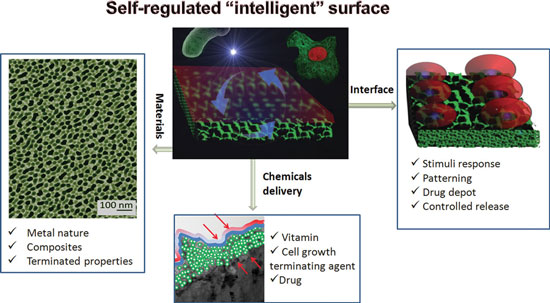| May 21, 2013 |
Nanotechnology surface architecture for bio applications
|
|
(Nanowerk News) Nanostructured surfaces that provide effective control over biomolecules/ cell/tissue deposition, growth and release can be considered as self-regulated “intelligent” surfaces. Recently, significant efforts and challenges have been directed to produce active surfaces with pronounced stimuli sensitive and feedback properties to achieve self-regulation. One of the successful examples are antifouling and self-healing coatings.
|
|
A new article in Advanced Functional Materials ("Surface Nanoarchitecture for Bio-Applications: Self-Regulating Intelligent Interfaces") by Ekaterina V. Skorb and Daria V. Andreeva highlights the latest achievements in construction of nanotechnology-enabled “intelligent” systems that could mimic biofunctions.
|
 |
| Design strategy for intelligent surfaces. Left: nanostructured metal surface (scanning electron microscope (SEM) image of a modifi ed metal surface of potential implants), platform for optimization/modifi cation of metal surfaces by formation of organic/inorganic composites. Right: formation of feedback coatings. Soft matter (micelles, hydrogels, polymer fi lms) sensitive to external stimuli, for example, T, pH, light, electrical, magnetic fi eld, grafted/adsorbed on the porous metal matrix. Bottom: generated porous nanonetwork well adhering to bulk metal as a universal encapsulation system suitable for multicomponent loading and time-resolved release. The metal surface capsules can be loaded with active agents, such as corrosion inhibitors, vitamins and drugs, enzymes, DNA fragments, or antibodies. (© Wiley)
|
|
Interfaces adapted to self-control and self-regulation require a complex hierarchical organization of stimuli responsive nanoorganized blocks. In living systems, nature broadly exploits the principles of hierarchical organization for self-control and stimuli responsive switching and self-regulation. However, synthetic intelligence is still a challenge. Even more challenging is in vivo design.
|
|
The two authors demonstrate how the blocks can be nanostructured and combined to provide system response to environmental changes, stimuli switchability. They focus on metal surfaces, that usually passive surface widely used for implantation. However, as shown in the article, nanostructuring of metal interfacial layer can provide novel characteristics that are attractive for intelligent surfaces. The potential of hybrids and composites for formation of active interfaces is also demonstrated. Polymer systems are suggested as nanoblocks for hierarchical organization in combination with metals.
|
|
The design of the 3D architecture surfaces with both spaceand time-dependent functionality (cell attraction, pH-trigged self-cleaning, antiseptic/disinfection) is a modern issue in bionanoingineering and materials science. Spatial and temporal biomolecule performance at the surface provided by the surface nanoarchitecture offers advanced bio-applications of metal based materials, such as implantation, organ-on chip and lab-on-chip, biosensors, smart biomaterials, drug delivery systems.
|
|
"We believe that the area will be explored further in nearest future," Skorb and Andreeva write. "A next step in active surface construction can be the surfaces that are applicable for a generation of entire organs due to spatially and temporally resolved co-culture growth regulated by morphology and functions of the interfacial layer."
|

